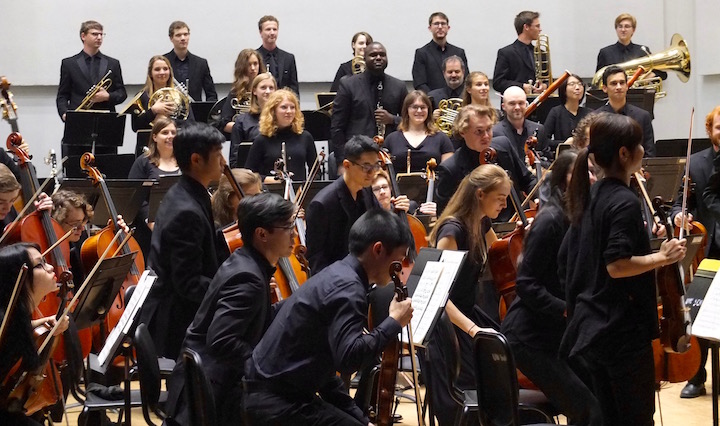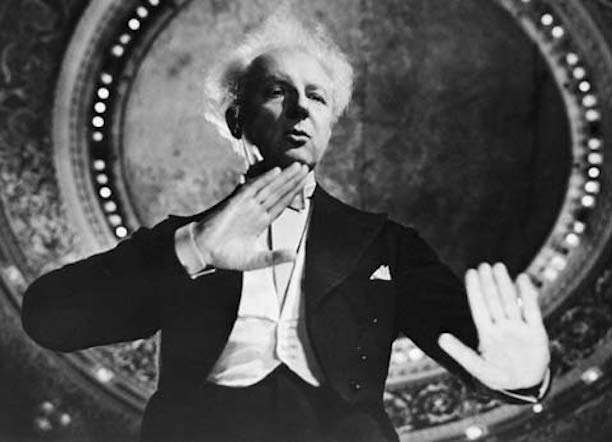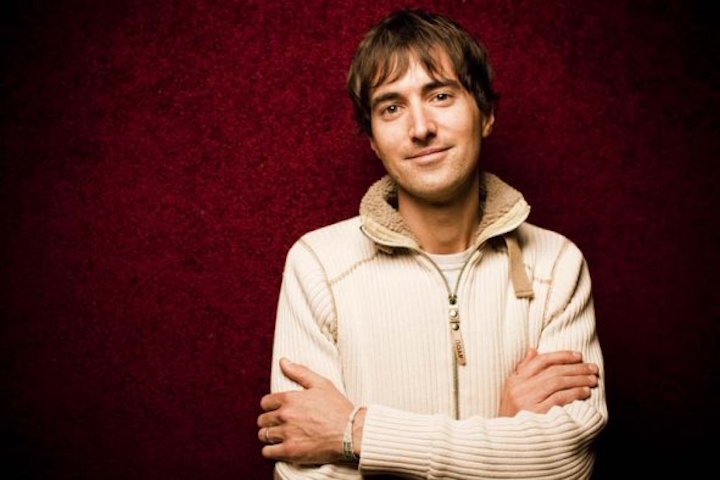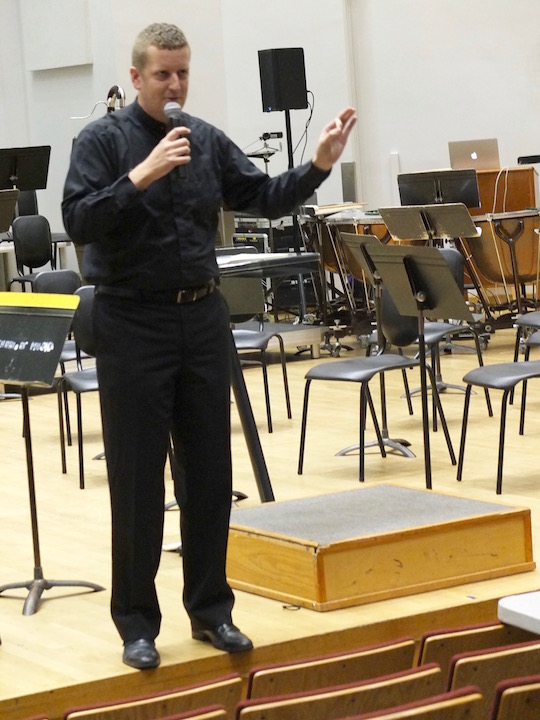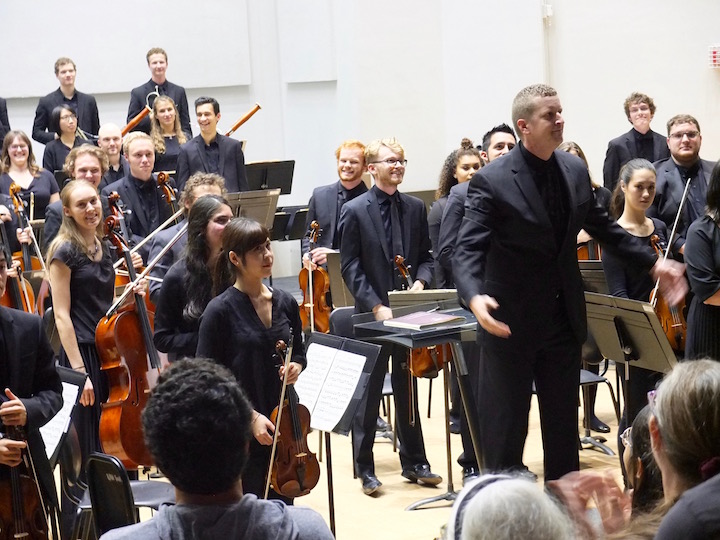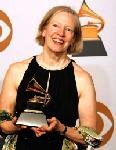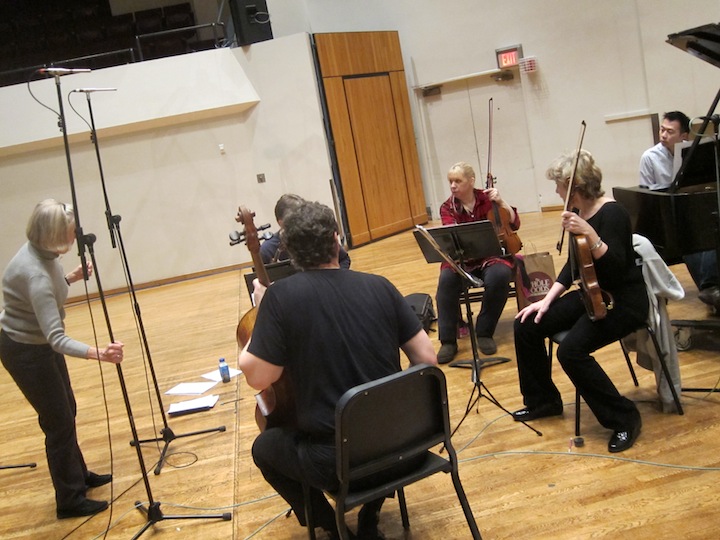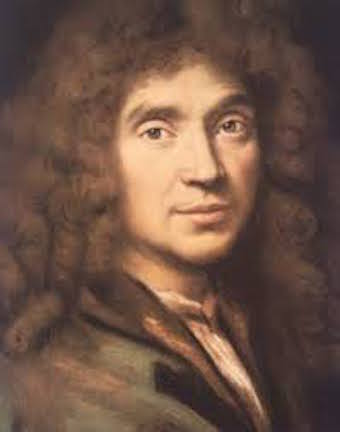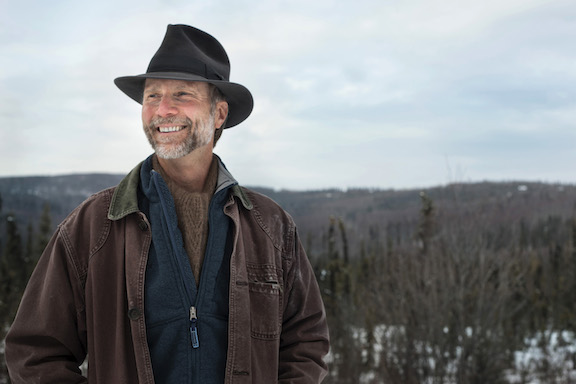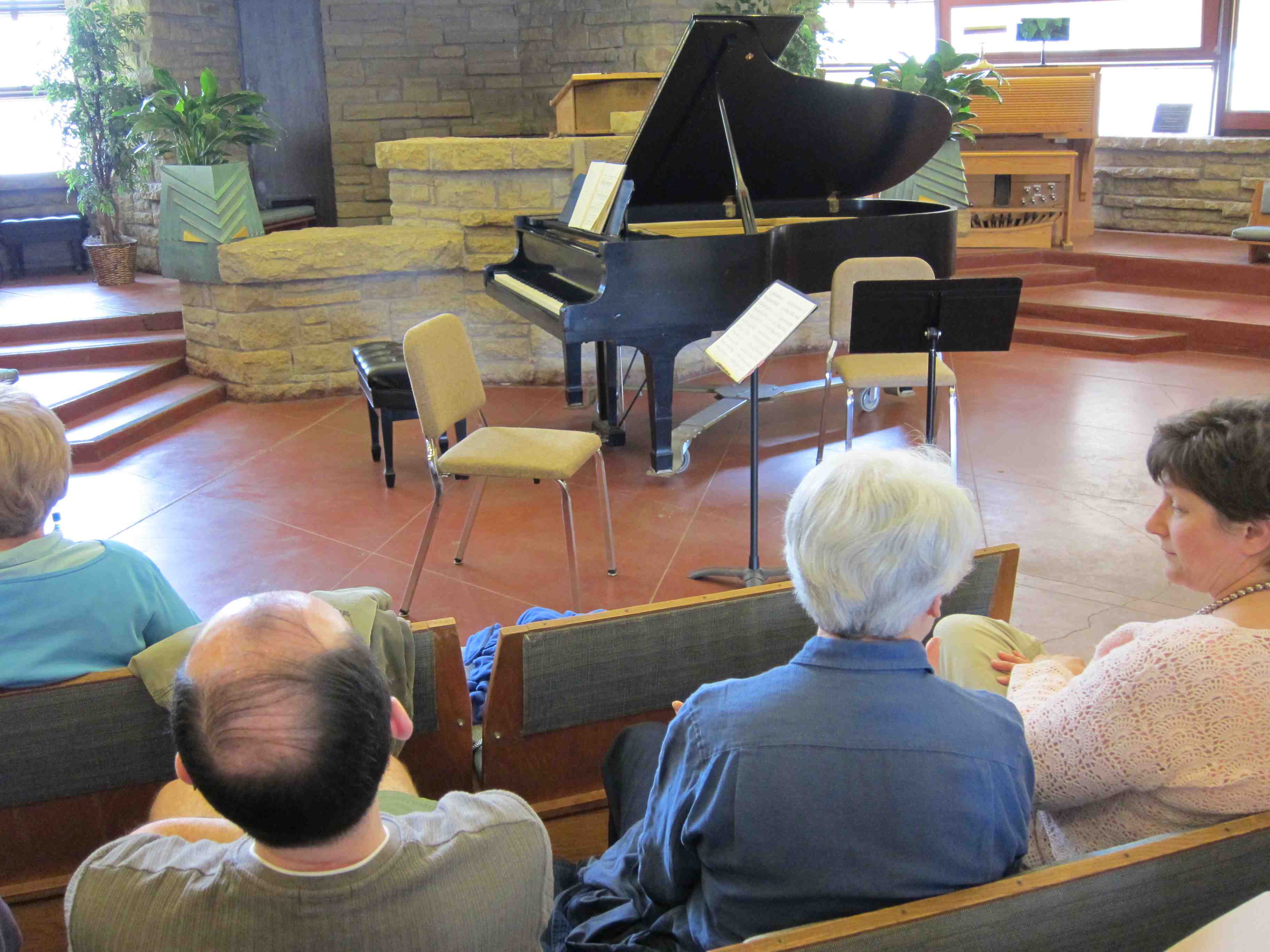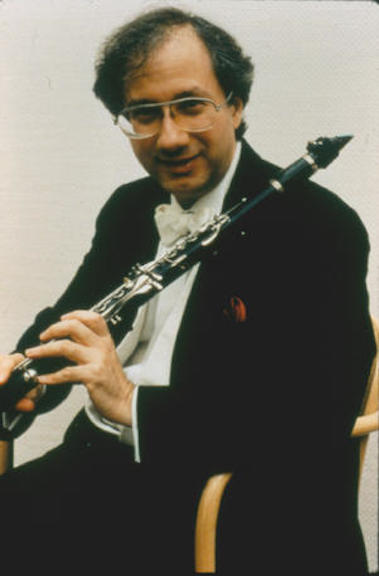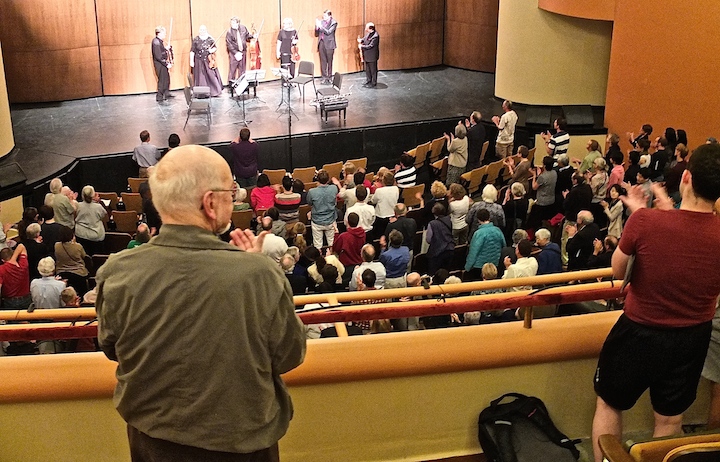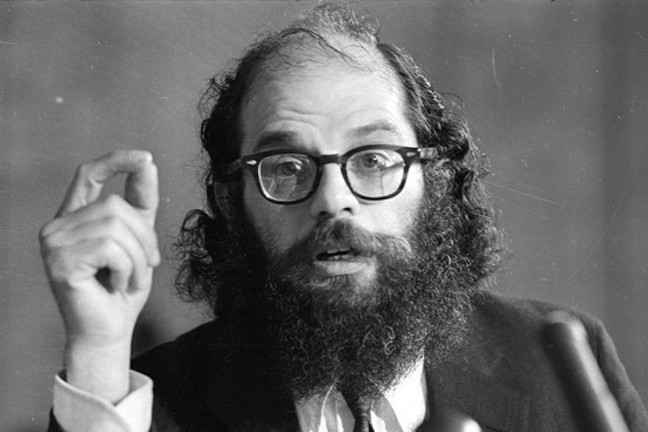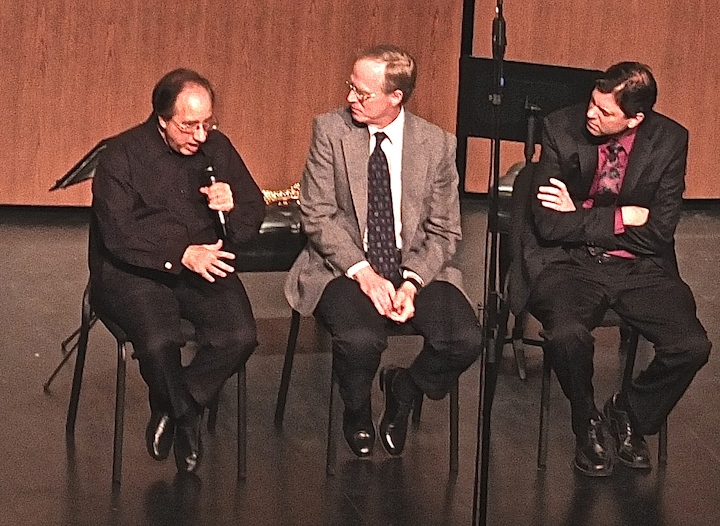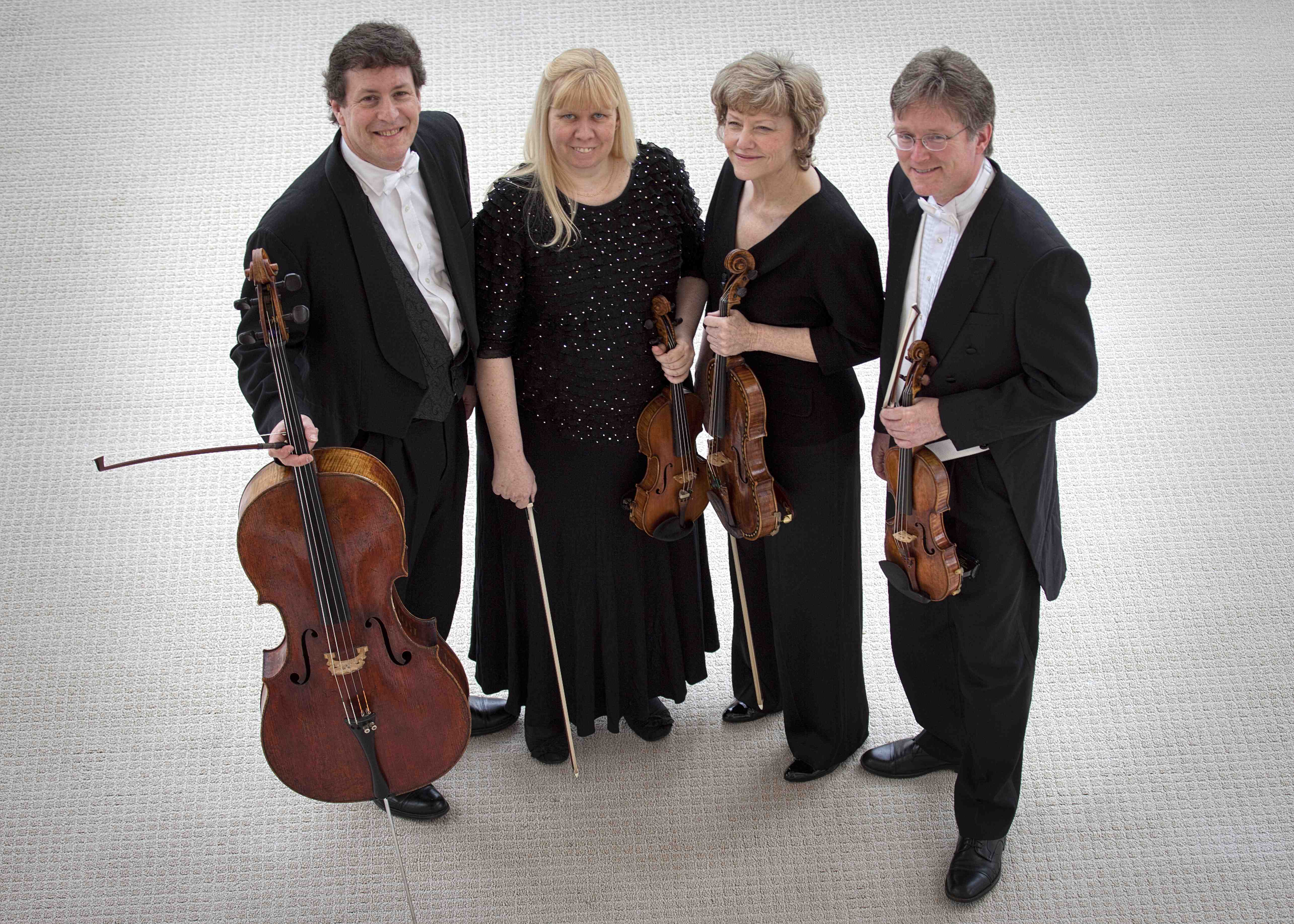The Well-Tempered Ear
Classical music: New faculty conductor Chad Hutchinson makes an impressive and promising debut with the UW Symphony Orchestra
2 Comments
By Jacob Stockinger
Last Saturday night, Chad Hutchinson (below), the new faculty conductor at the University of Wisconsin-Madison’s Mead Witter School of Music, made an impressive and promising debut with the UW Symphony Orchestra.
The ambitious program that Hutchinson put together says a lot about his priorities and instincts, and about his confidence in himself and the abilities of his student players, who performed superbly.
The varied works came from the early 19th century, the mid-19th century, the early 20th century and the 21st century. And it seemed that each piece in the ambitious program was chosen to put the spotlight on a different section – percussion, brass, strings and winds.
Curiously, The Ear found the most successful pieces were the most traditional ones.
The Prelude to the opera “Die Meistersinger von Nürnberg” by Richard Wagner received the right mix of horn pomp and string zest. It made The Ear realize again how much more he prefers Wagner’s instrumental music to his vocal music. Let’s hear more Wagner preludes, since we are unlikely to hear more Wagner operas.
The orchestral transcription by Leopold Stokowski (below) of the piano prelude “The Sunken Cathedral” by Claude Debussy was the least successful work of the night. This is the second overblown and bombastic Stokowski transcription that The Ear has heard performed live in a month.
Clearly, Stokowski’s aesthetic was Bigger is Better. This particular transcription strips away the mystery, sensuality and subtlety, the watery softness, of the original. It works more as an etude for orchestra than as an authentic expression of Impressionism. The Ear’s objections are to the transcription, not to the performance, which was well voiced, precise and tightly controlled.
“Mothership” by the popular American composer Mason Bates (below), who wrote the recent successful opera based on the life of the late Apple guru Steve Jobs, proved an interesting foray into contemporary music culture. It was also the Madison premiere of the 2011 work.
The electronic music in the pulsating and highly atmospheric score, including the computer-generated disco dance beat, highlighted the percussion section and the UW’s new Electro-Acoustic Research Space (EARS), which collaborated with the symphony orchestra.
The dramatic work, a novelty that is pop-infused and resembles music by John Adams a little too closely, has its pleasing and engaging moments. But overall it seems a triumph of style over substance. (You can judge for yourself from the performance with Michael Tilson Thomas in the YouTube video at the bottom.)
That said, Hutchinson nonetheless held the complex and coordinated score together, and the young audience seemed to take to the new music — a major achievement in itself.
Expect to hear many more contemporary works from Hutchinson, who says he is an unabashed champion of new music. He will include other living composers in many other concerts, including the next one on Nov. 4 and then again on Feb. 22.
To these ears, the most impressive performance came in the Symphony No. 3 “Eroica” by Ludwig van Beethoven. In its day, the difficult and long work proved revolutionary and perplexing. More recently, more than 100 conductors named it the best symphony ever written. You can’t get more establishment than that.
Yet despite being so mainstream, the “Eroica” remains a difficult and challenging work, both technically and interpretively. And this performance succeeded on both counts. That is no small feat for a new conductor and his young students to pull off in the first six weeks of school.
Especially impressive was Hutchinson’s choice to skip any pause between the third movement and the finale. It worked dramatically to maintain momentum. Such exciting attacks should be a more common practice in performing symphonies and concertos as well as chamber music.
Hutchinson seems a congenial and humorous concert hall host. His pre-concert talk (below), which he is slated to do at all performances, was helpful and informative, even if he repeated some major points when he introduced the actual performances. Hutchinson, intent on expanding the audience for classical music, is worth listening to.
Hutchinson may not possess an especially graceful or fluid podium presence that is pleasing to watch, but he gets results. Certainly both the student players and the large audience (below) seemed pleased and excited by these performances.
In the end, the concert provided plenty of reasons to look forward to hearing more from Chad Hutchinson and seeing how he develops and leaves his mark on programming and performing at the UW.
Were you there as either a performer or an audience member?
What did you think of the concert and of Chad Hutchinson’s debut?
The Ear wants to hear.
Tags: 19th century, 20th-century, 21st century, aesthetic, African American, air, Apple, arrangament, Arts, attack, audience, Beat, Beethoven, brass, Cello, century, Chamber music, champion, Classical music, composer, computer, concert hall, concerto, conduct, conductor, contemporary, control, culture, Debussy, debut, Die Meistersinger von Nürnberg, disco, egg, electronic, Electronic music, Eroica Symphony, esthetic, etude, excitement, exciting, expression, faculty, fance, finale, guru, hi tech, Horn, host, Impressionism, Impressionist, impressive, instrument, instrumental, interpretation, Jacob Stockinger, lecture, live, living, Ludwig van Beethoven, Madison, Mason Bates, Mead Witter School of Music, Michael Tilson Thomas, Mothership, movement, Music, musical, mystery, New Music, novel, opera, operatic, Orchestra, original, percussion, performer, Piano, podium, pomp, Prelude, premiere, professor, program, programming, promising, revolution, revolutionary, Richard Wagner, school, soufflé, Steve Jobs, Stokowski, string, strings, subtlety, symphony, talk, technology, The Sunken Cathedral, transcription, United States, University of Wisconsin-Madison School of Music, University of Wisconsin–Madison, UW Symphony Orchestra, Viola, Violin, vocal, vocal music, water, winds, YouTube, zest
Classical music: Here are the 2015 Grammy winners and the nominees for classical music. Pro Arte Quartet recording producer Judith Sherman wins again.
6 Comments
By Jacob Stockinger
The 2015 Grammy winners were announced Sunday night in a live three-hour broadcast.
The list of winners and nominees can be a good guide to new listening.
Of course most of the Grammy attention went to pop, rock, rap, country and the big selling music genres.
But here are the winners for classical music, along with the nominees and competition.
One thing to note: Producer of the Year again went to freelancer Judith Sherman (below).
Sherman will be in Madison again inn May to record the last two centennial commissions for the University of Wisconsin-Madison‘s Pro Arte Quartet. (Below, she is seen recording the first four commissions with the Pro Arte in Mills Hall.) The new recording includes the terrific Clarinet Quintet based on Allen Ginsberg’s landmark Beat poem “Howl” by American composer Pierre Jalbert and Belgian composer Benoît Mernier’s String Quartet No. 3.
BEST ENGINEERED ALBUM, CLASSICAL
WINNER: Vaughan Williams (below): Dona Nobis Pacem; Symphony No. 4; The Lark Ascending. Michael Bishop, engineer; Michael Bishop, mastering engineer (Robert Spano, Norman Mackenzie, Atlanta Symphony Orchestra & Chorus). Label: ASO Media
Adams, John: City Noir. Richard King, engineer; Wolfgang Schiefermair, mastering engineer (David Robertson & St. Louis Symphony); Label: Nonesuch
Adams, John Luther: Become Ocean. Dmitriy Lipay & Nathaniel Reichman, engineers; Nathaniel Reichman, mastering engineer (Ludovic Morlot & Seattle Symphony) Label: Cantaloupe Music
Dutilleux: Symphony No. 1; Tout Un Monde Lointain; The Shadows Of Time. Dmitriy Lipay, engineer; Dmitriy Lipay, mastering engineer (Ludovic Morlot & Seattle Symphony). Label: Seattle Symphony Media
Riccardo Muti Conducts Mason Bates & Anna Clyne. David Frost & Christopher Willis, engineers; Tim Martyn, mastering engineer (Riccardo Muti & Chicago Symphony Orchestra). Label: CSO Resound
PRODUCER OF THE YEAR, CLASSICAL
WINNER: Judith Sherman (below)
- Beethoven: Cello & Piano Complete (Fischer Duo)
- Brahms By Heart (Chiara String Quartet)
- Composing America (Lark Quartet)
- Divergence (Plattform K + K Vienna)
- The Good Song (Thomas Meglioranza)
- Mozart & Brahms: Clarinet Quintets (Anthony McGill & Pacifica Quartet)
- Snapshot (American Brass Quintet)
- Two X Four (Jaime Laredo, Jennifer Koh, Vinay Parameswaran & Curtis 20/21 Ensemble)
- Wagner Without Words (Williams)
Morten Lindberg
- Beppe: Remote Galaxy (Vladimir Ashkenazy & Philharmonia Orchestra)
- Dyrud: Out Of Darkness (Vivianne Sydnes & Nidaros Cathedral Choir)
- Ja, Vi Elsker (Tone Bianca Sparre Dahl, Ingar Bergby, Staff Band Of The Norwegian Armed Forces & Schola Cantorum)
- Symphonies Of Wind Instruments (Ingar Bergby & Royal Norwegian Navy Band)
Dmitriy Lipay
- Adams, John Luther: Become Ocean (Ludovic Morlot & Seattle Symphony)
- Dutilleux: Symphony No. 1; Tout Un Monde Lointain; The Shadows Of Time (Ludovic Morlot & Seattle Symphony)
- Fauré: Masques Et Bergamasques; Pelléas Et Mélisande; Dolly (Ludovic Morlot, Seattle Symphony Chorale & Seattle Symphony)
- Hindemith: Nobilissima Visione; Five Pieces For String Orchestra (Gerard Schwarz & Seattle Symphony)
- Ives: Symphony No. 2; Carter: Instances; Gershwin: An American In Paris (Ludovic Morlot & Seattle Symphony)
- Ravel: Orchestral Works; Saint-Saëns: Organ Symphony (Ludovic Morlot & Seattle Symphony)
Elaine Martone
- Hallowed Ground (Louis Langrée, Maya Angelou, Nathan Wyatt & Cincinnati Symphony Orchestra)
- Mahler: Symphony No. 2 ‘Resurrection’ (Benjamin Zander, Stefan Bevier, Philharmonia Chorus & Orchestra)
- Sibelius: Symphonies Nos. 6 & 7; Tapiola (Robert Spano & Atlanta Symphony Orchestra)
- Vaughan Williams: Dona Nobis Pacem; Symphony No. 4; The Lark Ascending (Robert Spano, Norman Mackenzie, Atlanta Symphony Orchestra & Chorus)
David Starobin
- All The Things You Are (Leon Fleisher)
- Complete Crumb Edition, Vol. 16 (Ann Crumb, Patrick Mason, James Freeman & Orchestra 2001)
- Game Of Attrition – Arlene Sierra, Vol. 2 (Jac Van Steen & BBC National Orchestra Of Wales)
- Haydn, Beethoven & Schubert (Gilbert Kalish)
- Mozart: Piano Concertos, No. 12, K. 414 & No. 23, K. 488 (Marianna Shirinyan, Scott Yoo & Odense Symphony Orchestra)
- Music Of Peter Lieberson, Vol. 3 (Scott Yoo, Roberto Diaz, Steven Beck & Odense Symphony Orchestra)
- Rochberg, Chihara & Rorem (Jerome Lowenthal)
- Tchaikovsky: The Tempest, Op. 18 & Piano Concerto No. 1, Op. 23 (Joyce Yang, Alexander Lazarev & Odense Symphony Orchestra
BEST ORCHESTRAL PERFORMANCE
WINNER: Adams, John (below): City Noir. David Robertson, conductor (St. Louis Symphony). Label: Nonesuch
Dutilleux: Symphony No. 1; Tout Un Monde Lointain; The Shadows Of Time. Ludovic Morlot, conductor (Seattle Symphony). Label: Seattle Symphony Media
Dvořák: Symphony No. 8; Janáček: Symphonic Suite From Jenůfa. Manfred Honeck, conductor (Pittsburgh Symphony Orchestra). Label: Reference Recordings
Schumann: Symphonien 1-4. Simon Rattle, conductor (Berliner Philharmoniker). Label: Berliner Philharmoniker Recordings.
Sibelius: Symphonies Nos. 6 & 7; Tapiola. Robert Spano, conductor (Atlanta Symphony Orchestra). Label: ASO Media
BEST OPERA RECORDING
WINNER: Charpentier (below): La Descente D’Orphée Aux Enfers. Paul O’Dette & Stephen Stubbs, conductors; Aaron Sheehan; Renate Wolter-Seevers, producer (Boston Early Music Festival Chamber Ensemble; Boston Early Music Festival Vocal Ensemble). Label: CPO
Milhaud: L’Orestie D’Eschyle. Kenneth Kiesler, conductor; Dan Kempson, Jennifer Lane, Tamara Mumford, Sidney Outlaw, Lori Phillips & Brenda Rae; Tim Handley, producer (University Of Michigan Percussion Ensemble & University Of Michigan Symphony Orchestra; University Of Michigan Chamber Choir, University Of Michigan Orpheus Singers, University Of Michigan University Choir & UMS Choral Union). Label: Naxos
Rameau: Hippolyte Et Aricie. William Christie, conductor; Sarah Connolly, Stéphane Degout, Christiane Karg, Ed Lyon & Katherine Watson; Sébastien Chonion, producer (Orchestra Of The Age Of Enlightenment; The Glyndebourne Chorus). Label: Opus Arte
Schönberg: Moses Und Aron. Sylvain Cambreling, conductor; Andreas Conrad & Franz Grundheber; Reinhard Oechsler, producer (SWR Sinfonieorchester Baden-Baden Und Freiburg; EuropaChorAkademie). Label: Hänssler Classic
Strauss: Elektra. Christian Thielemann, conductor; Evelyn Herlitzius, Waltraud Meier, René Pape & Anne Schwanewilms; Arend Prohmann, producer (Staatskapelle Dresden; Sächsischer Staatsopernchor Dresden). Label: Deutsche Grammophon
BEST CHORAL PERFORMANCE
WINNER: The Sacred Spirit Of Russia. Craig Hella Johnson, conductor (Conspirare). Label: Harmonia Mundi
Bach: Matthäus-Passion. René Jacobs, conductor (Werner Güra & Johannes Weisser; Akademie Für Alte Musik Berlin; Rias Kammerchor & Staats-Und Domchor Berlin). Label: Harmonia Mundi
Dyrud: Out Of Darkness. Vivianne Sydnes, conductor (Erlend Aagaard Nilsen & Geir Morten Øien; Sarah Head & Lars Sitter; Nidaros Cathedral Choir). Label: 2L (Lindberg Lyd).
Holst: First Choral Symphony; The Mystic Trumpeter. Andrew Davis, conductor; Stephen Jackson, chorus master (Susan Gritton; BBC Symphony Orchestra; BBC Symphony Chorus). Label: Chandos Records
Mozart: Requiem. John Butt, conductor (Matthew Brook, Rowan Hellier, Thomas Hobbs & Joanne Lunn; Dunedin Consort). Label: Linn Records
BEST CHAMBER MUSIC/SMALL ENSEMBLE PERFORMANCE
WINNER: In 27 Pieces – The Hilary Hahn Encores (below). Hilary Hahn & Cory Smythe. Label: Deutsche Grammophon
Dreams & Prayers. David Krakauer & A Far Cry. Label: Crier Records
Martinů: Cello Sonatas Nos. 1-3. Steven Isserlis & Olli Mustonen. Label: BIS
Partch: Castor & Pollux. Partch. Track from: Partch: Plectra & Percussion Dances. Label: Bridge Records, Inc.
Sing Thee Nowell. New York Polyphony. Label: BIS
BEST CLASSICAL INSTRUMENTAL SOLO
WINNER: Play. Jason Vieaux. Label: Azica Records
All The Things You Are. Leon Fleisher. Label: Bridge Records, Inc.
The Carnegie Recital. Daniil Trifonov. Label: Deutsche Grammophon
Dutilleux: Tout Un Monde Lointain. Xavier Phillips; Ludovic Morlot, conductor (Seattle Symphony). Track from: Dutilleux: Symphony No. 1; Tout Un Monde Lointain; The Shadows Of Time. Label: Seattle Symphony Media
Toccatas. Jory Vinikour. Label: Sono Luminus
BEST CLASSICAL SOLO VOCAL ALBUM
WINNER: Douce France. Anne Sofie Von Otter; Bengt Forsberg, accompanist (Carl Bagge, Margareta Bengston, Mats Bergström, Per Ekdahl, Bengan Janson, Olle Linder & Antoine Tamestit). Label: Naïve
Porpora: Arias. Philippe Jaroussky; Andrea Marcon, conductor (Cecilia Bartoli; Venice Baroque Orchestra) Label: Erato
Schubert: Die Schöne Müllerin. Florian Boesch; Malcolm Martineau, accompanist. Label: Onyx
Stella Di Napoli. Joyce DiDonato; Riccardo Minasi, conductor (Chœur De L’Opéra National De Lyon; Orchestre De L’Opéra National De Lyon). Label: Erato/Warner Classics
Virtuoso Rossini Arias. Lawrence Brownlee; Constantine Orbelian, conductor (Kaunas City Symphony Orchestra). Label: Delos
BEST CLASSICAL COMPENDIUM
WINNER: Partch (below): Plectra & Percussion Dances. Partch; John Schneider, producer. Label: Bridge Records, Inc.
Britten To America. Jeffrey Skidmore, conductor; Colin Matthews, producer. Label: NMC Recordings
Mieczysław Weinberg. Giedrė Dirvanauskaitė, Daniil Grishin, Gidon Kremer, & Daniil Trifonov & Kremerata Baltica; Manfred Eicher, producer. Label: ECM New Series
Mike Marshall & The Turtle Island Quartet. Mike Marshall & Turtle Island Quartet; Mike Marshall, producer. Label: Adventure Music
The Solent – Fifty Years Of Music By Ralph Vaughan Williams. Paul Daniel, conductor; Andrew Walton, producer. Label: Albion Records
BEST CONTEMPORARY CLASSICAL COMPOSITION
WINNER: Adams, John Luther (below): Become Ocean. John Luther Adams, composer (Ludovic Morlot & Seattle Symphony). Label: Cantaloupe Music
Clyne, Anna: Prince Of Clouds. Anna Clyne, composer (Jaime Laredo, Jennifer Koh, Vinay Parameswaran & Curtis 20/21 Ensemble). Track from: Two X Four. Label: Cedille Records
Crumb, George: Voices From The Heartland. George Crumb, composer (Ann Crumb, Patrick Mason, James Freeman & Orchestra 2001). Track from: Complete Crumb Edition, Vol. 16. Label: Bridge Records, Inc.
Paulus, Stephen: Concerto For Two Trumpets & Band. Stephen Paulus, composer (Eric Berlin, Richard Kelley, James Patrick Miller & UMASS Wind Ensemble). Track from: Fantastique – Premieres For Trumpet & Wind Ensemble. Label: MSR Classics
Sierra, Roberto: Sinfonía No. 4. Roberto Sierra, composer (Giancarlo Guerrero & Nashville Symphony). Track from: Sierra: Sinfonía No. 4; Fandangos; Carnaval. Label: Naxos
Tags: Allen Ginsberg, Arts, Atlanta Symphony, Atlanta Symphony Orchestra, Bach, Bassoon, BBC Symphony Orchestra, Beat, Beat poets, Beethoven, Benjamin Britten, BIS, Bohuslav Martinu, Bridge Records, Carnegie Hall, Cello, Chamber music, Chandos, Charpentier, Chicago, Chicago Symphony Orchestra, clarinet, Classical, Classical music, Compact Disc, concerto, Daniil Trifonov, Deutsche Grammophon, Dutilleux, Dvorak, Early music, ECM, encore, Erato, Faure, Gerard Schwartz, Gershwin, Grammy, Grammy Award, Grammy Award for Best Classical Compendium, Grammy Award for Best Classical Instrumental Solo, Grammy Award for Best Engineered Album, Haydn, Hilary Hahn, Hindemith, Holst, Howl, Ives, Jacob Stockinger, Johann Sebastian Bach, Johannes Brahms, John Adams, John Luther Adams, Joyce DiDonato, Leon Fleisher, Ludwig van Beethoven, Madison, Mahler, Milhaud, Mozart, Music, Non-Classical, Nonesuch, Norway, Onyx, Orchestra, Partch, Piano, Pro Arte Quartet, quintet, Rameau, Ravel, Requiem, Riccardo Muti, Richard Strauss, Richberg, Robert Schumann, Rochberg, Rorem, Rossini, Russia, Schoenberg, Schubert, Seattle, Sibekius, Sibelius, singer, St. Louis, St. Louis Symphony, Stephen Paulus, strings, symphony, Tchaikovsky, United States, University of Wisconsin-Madison School of Music, University of Wisconsin–Madison, vaughan williams, Violin, Vladimir Ashkenazy, vocal music, Wagner, Weinberg, Wisconsin, Woodwind quintet
Classical music: Each week NPR now says TGIF via Twitter. Check it out. Plus, this afternoon brings a lot of live music, including the repeat performance of the MUST-HEAR world premiere of Pierre Jalbert’s Clarinet Quintet based on Allen Ginsberg’s Beat poem “Howl”; the UW-Madison Symphony Orchestra in Mahler and Schumann; and the Ancora String Quartet.
Leave a Comment
ALERT: Just a reminder that there is a lot of live music competing for audiences this afternoon. But if you can, be sure to catch the UW-Madison Pro Arte Quartet and guest clarinetist Charles Neidich giving the FREE second world premiere performance of American composer Pierre Jalbert‘s Clarinet Quintet — which is based on Beat poet Allen Ginsberg’s “Howl” — at the Chazen Museum of Art at 12:30 p.m. in Brittingham Gallery 3. The new work, which The Ear heard on Friday night, is the real thing: a winning gem of new music. Of course the short-sighted Wisconsin Public Radio is no longer broadcasting local and regional live music from the museum, so forget the radio. But you can stream the concert live from the Internet at the museum’s website www.chazen.wisc.edu.
And here is a link with an overview of all the music concerts available this afternoon:
Well, here is another reason to welcome the end of the work week and the coming of the weekend.
NPR is saying TGIF.
Every Friday afternoon, the Deceptive Cadence blog folks at National Public Radio gather with the public via Twitter to check out issues and performers, performances and recordings — including the new CD “Motherland” by pianist Khatia Buniatishvili (the Sony Classical CD cover with her Frida Kahlo-like portrait is below and a sample is at the bottom in a YouTube video in which she plays an arrangement of Johann Sebastian Bach‘s “Sheep May Safely Graze“). You should try checking it out and add your own comments and recommendations.
And that’s just what you can do using the link below:
The Ear thinks you will like it for several reasons.
The discussion keeps you updated on new recordings, new performers and new music. But it also suggests older composers and repertoire to listen to, including recommended interpretations of that repertoire.
It also features some very insightful and some very funny comments from other readers and followers that you can check out.
So don’t be afraid to hop on in – or at least to add to your To Do List checking out Deceptive Cadence at NPR every Friday.
Tags: Allen Ginsberg, Arts, Beat, Beat generation, Beat poetry, Cadence (music), Chamber music, Charles Neidich, Chazen Museum of Art, clarinet, Classical music, Compact Disc, Deceptive Cadence, Frida Kahlo, Friday, Howl, Jacob Stockinger, Johann Sebastian Bach, Khatia Buniatishvili, National Public Radio, NPR, opera, Orchestra, Pierre Jalbert, Pro Arte Quartet, SONY, Sony Classical, TGIF (ABC), Twitter, University of Wisconsin-Madison School of Music, University of Wisconsin–Madison, wisconsin public radio, YouTube
Classical music: The FREE world premiere by the Pro Arte Quartet of American composer Pierre Jalbert’s Clarinet Quintet — based on Beat poet Allen Ginsberg’s “Howl” — takes place this coming Friday night at 8 p.m. in the renovated Wisconsin Union Theater. The concert includes a composer interview and then a FREE dessert reception, where you can meet the composer and performers. A FREE encore performance is on this Sunday afternoon at 12:30 p.m. at the Chazen Museum of Art and will be web-streamed live.
4 Comments
By Jacob Stockinger
This coming Friday night will bring the FREE world premiere of the final work of the six commissions to mark the centennial of the Pro Arte String Quartet (below, in a photo by Rick Langer) at the University of Wisconsin-Madison School of Music.
The work is a Clarinet Quintet, written Pierre Jalbert (below), a prize-winning American composer with French-Canadian roots. It will receive its world premiere at 8 p.m. on Friday night in the newly renovated Wisconsin Union Theater. A FREE dessert reception in the Memorial Union follows. There is also a FREE and OPEN TO THE PUBLIC rehearsal, with the composer advising the string quartet, from 9 a.m. to noon on this Thursday morning in Mills Hall.
Here is a link to the Pro Arte Quartet’s website
And here is the official press release about the new work and the upcoming concert. It was researched and written by Mike Muckian (below), who also writes and blogs for Brava Magazine and the Wisconsin Gazette.
MADISON, Wis. – When Beat Generation poet Allen Ginsberg (below) published “Howl” in 1956, he may have anticipated the obscenity charges he faced because of the work’s highly charged content. Chances are he didn’t foresee his epic poem, now considered a significant work of American literature, as the source of inspiration for a 21st-century chamber music composition.
Pierre Jalbert, an American composer of French-Canadian descent, thought otherwise. When commissioned by the University of Wisconsin-Madison Pro Arte Quartet to compose an original work to help the quartet celebrate its centennial season, Jalbert chose Ginsberg’s poem as his source of inspiration.
Jalbert’s “Howl” for clarinet and string quartet will receive its world premiere by the Pro Arte on Friday, Sept. 26, at the Wisconsin Union Theater in the historic Memorial Union on the University of Wisconsin-Madison campus.
The event, free and open to the public, will be the first classical music concert to take place in the venerable theater’s newly refurbished Shannon Hall (below top).
The 8 p.m. concert will be preceded by a 7 p.m. concert preview discussion with Pierre Jalbert in Shannon Hall. In addition to Jalbert’s composition, the evening’s program includes the String Quartet No. 2 in A Major (1824) by Juan Crisóstomo Arriaga (below top) -– known as “the Spanish Mozart” — and the gorgeous Clarinet Quintet in A Major (1791) by Wolfgang Amadeus Mozart (below bottom).
The Pro Arte Quartet (below, in a photo by Rick Langer) includes violinists David Perry and Suzanne Beia, violist Sally Chisholm and cellist Parry Karp.
PLEASE NOTE: The Pro Arte Quartet concert will be repeated Sunday, Sept. 28, at 12:30 p.m. in Gallery III at the Chazen Museum of Art, also on the UW-Madison campus. The concert will be streamed live worldwide on the Internet by the Madison-based Audio for the Arts. Check the Chazen Museum of Art’s website (www.chazen.wisc.edu) on the day of the concert. Details of the Chazen music series for 2015 will be announced on Sunday at the concert. The new series is designed to replace the “Sunday Afternoon Live From the Chazen” series (below) of live chamber music concerts that was abruptly canceled by Wisconsin Public Radio last spring after 36 years. Sunday’s concert is FREE and OPEN to the public; however, Chazen Museum of Art members can call 608-263-2246 to reserve seating.
Joining the Pro Arte for both concerts will be guest clarinetist Charles Neidich (below, in a photo by Sallie Eichson), a regular member of the New York City-based Orpheus Chamber Orchestra and noted guest performer with orchestras and string quartets worldwide. Here is a link to Neidich’s own impressive website:
“The Jalbert quintet is a very exciting composition, often very rhythmic, but with very serenely quiet contrasting sections,” said Neidich. “It is also interesting in that the clarinetist has to switch to bass clarinet, creating a very different sound for the group.” (At bottom is a YouTube interview with Pierre Jalbert, who explains his philosophy of composing and his concern with the audience’s understanding of his work.)
Ginsberg (below, young), who died in 1997, began work on “Howl” as early as 1954. The poem was first published in “Howl and Other Poems” in 1956 as part of the “Pocket Poets” series by fellow beat poet Lawrence Ferlinghetti, also known as founder of City Lights Books in San Francisco.
Upon the poem’s release, both Ferlinghetti and City Lights manager Shigeyoshi Murao were arrested and charged with distributing obscene material because of the poem’s profanity, drug references and frank sexual content. Four months later, Judge Clayton Horn ruled that the work was not obscene and charges against Ferlinghetti and his employee were dropped.
Judge Horn deemed “Howl” to have redeeming social content, and over the years it has proved its worth both in terms of social and literary value, according to Dr. Lynn Keller, the Martha Meier Renk Bascom Professor of Poetry in the UW-Madison Department of English.
“’Howl’ stands out stylistically in its compellingly and varied repetition of words beginning successive lines, its near surrealist imagery, and its combination of agonized depictions at once hellish and lofty with a very appealing sense of humor,” Dr. Keller said. “In terms of content, it also stands out in celebrating the down-and-out hipster as spiritual quester and visionary.”
As part of the Beat Generation – as much a social as a literary phenomenon – Ginsberg’s celebration of physical pleasures and suspicions about “the military industrial complex” created a new path that still appeals to younger audiences.
“It is a powerful poem, a howl from the heart of an agonized generation in a repressive era,” Dr. Keller said.
Jalbert was familiar with the poem prior to the Pro Arte commission, but it was only after he started composing the work that he began to realize the influence Ginsberg had on the music. Those similarities had less to do with the poem’s content and more to do with its structure and rhythm, the composer said.
“At the beginning of my piece, the clarinet is basically playing long tones, creating a long line much like the long lines in Ginsberg’s poem, while the strings present the rhythmically pulsating harmonic underpinning,” Jalbert said. “Ginsberg’s poem has been called a ‘litany of praise,’ and the second movement of my work becomes a litany, much like a series of prayers in a liturgy, with the strings creating chant-like lines while the clarinet becomes the vox Dei, or “voice of God,” hovering mysteriously over everything. The third movement returns to the musical materials from the first movement, but now the bass clarinet takes on the virtuosic role.”
In keeping with emotional soundings in parts of “Howl,” Jalbert also has attempted to capture the “shrieks” that were characteristic to the poem alongside the aforementioned litany of praise.
“There are buildups to shrieking moments in my piece as well as a “howl” motive of a low chord slurred up to an immediate high cluster, all played very forcefully,” said Jalbert. “There’s also something very urban about parts of the poem and to me, there’s an urban quality in my first and third movements. There are also many religious allusions and the last words of Christ on the cross, so the second movement uses some of this.”
The Jalbert composition is the final of six commissions for the Pro Arte Centennial seasons, and it has all the earmarks of a contemporary work with staying power, according to clarinetist Neidich.
“Having studied the score, I believe that it will be accessible to listeners and exciting to hear,” said Neidich. “It features the clarinet both in the role of soloist and as contributor to the sonority of the ensemble. It has all the necessary attributes to become a significant work.”
The Jalbert commission also brings to an end the Pro Arte’s seasons of centennial celebration in honor of the quartet’s long and storied history.
The Quatuor Pro Arte of Brussels, first formed in 1911-1912, was performing quartets by Ludwig van Beethoven at the then-new Wisconsin Union Theater on the UW-Madison campus on May 10, 1940, when Belgium was overrun and occupied by Nazi forces, turning three of its original four musicians into war orphans.
By October of that year, the group had officially become the UW Pro Arte Quartet, making it the first artists ensemble-in-residence at any university in the world. At more than 100 years old, Pro Arte also is thought to be the world’s oldest continuously performing string quartet.
The Pro Arte in May traveled back to Belgium to perform the European premiere of its fifth centennial commissioned work, Belgian composer Benoît Mernier’s String Quartet No. 3. The work had received its world premiere on March 1 in Mills Concert Hall in the Mosse Humanities Building on the UW-Madison campus with the composer in attendance.
A 2-CD set (below) of the first four commissions was released last year by Albany Records. It includes two string quartets by Walter Mays and John Harbison as well as two piano quintets, one by William Bolcom and the other by Paul Schoenfield.
Tags: Albany Records, Allen Ginsberg, Ariaga, Arts, Beat, Beat poet, Beethoven, Belgium, Benoit Mernier, Cello, Chamber music, Charles Neidich, Chazen Museum of Art, clarinet, Clarinet Quintet, Classical music, Hitler, Howl, Jacob Stockinger, John Harbison, Juan Crisóstomo Arriaga, Lawrence Ferlinghetti, Lynn Keller, Madison, Memorial Union, Mozart, Music, Nazi, New York City, Paul Schoenfield, Pierre Jalbert, Pro Arte Quartet, quintet, Shannon Hall, United States, University of Wisconsin-Madison School of Music, University of Wisconsin–Madison, Violin, Walter Mays, WILLIAM BOLCOM, wisconsin public radio, Wisconsin Union Theater, Wolfgang Amadeus Mozart










